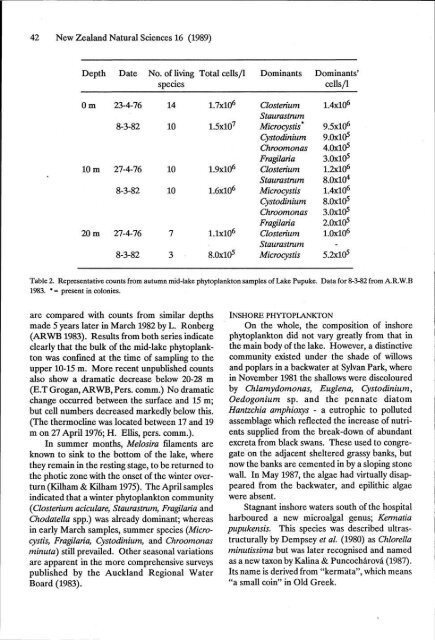MICRO-ALGAE OF LAKE PUPUKE, AUCKLAND, NEW ZEALAND
MICRO-ALGAE OF LAKE PUPUKE, AUCKLAND, NEW ZEALAND
MICRO-ALGAE OF LAKE PUPUKE, AUCKLAND, NEW ZEALAND
Create successful ePaper yourself
Turn your PDF publications into a flip-book with our unique Google optimized e-Paper software.
42 New Zealand Natural Sciences 16 (1989)<br />
Depth Date No. of living Total cells/1 Dominants Dominants'<br />
species cells/1<br />
Om<br />
10 m<br />
20 m<br />
23-4-76<br />
8-3-82<br />
27-4-76<br />
8-3-82<br />
27-4-76<br />
8-3-82<br />
14<br />
10<br />
10<br />
10<br />
7<br />
3<br />
1.7xl0 6<br />
1.5xl0 7<br />
1.9xl0 6<br />
1.6xl0 6<br />
l.lxlO 6<br />
8.0x10 s<br />
Closterium<br />
Staurastrum<br />
Microcystis*<br />
Cystodinium<br />
Chroomonas<br />
Fragilaria<br />
Closterium<br />
Staurastrum<br />
Microcystis<br />
Cystodinium<br />
Chroomonas<br />
Fragilaria<br />
Closterium<br />
Staurastrum<br />
Microcystis<br />
1.4xl0 6<br />
9.5xl0 6<br />
9.0x10 s<br />
4.0x10 s<br />
3.0x10 s<br />
1.2xl0 6<br />
8.0xl0 4<br />
1.4xl0 6<br />
8.0x10 s<br />
3.0x10 s<br />
2.0x10 s<br />
l.OxlO 6<br />
5.2x10 s<br />
Table 2. Representative counts from autumn mid-lake phytoplankton samples of Lake Pupuke. Data for 8-3-82 from A.R.W.B<br />
1983. * = present in colonies.<br />
are compared with counts from similar depths INSHORE PHYTOPLANKTON<br />
made 5 years later in March 1982 by L. Ronberg On the whole, the composition of inshore<br />
(ARWB 1983). Results from both series indicate phytoplankton did not vary greatly from that in<br />
clearly that the bulk of the mid-lake phytoplank the main body of the lake. However, a distinctive<br />
ton was confined at the time of sampling to the community existed under the shade of willows<br />
upper 10-15 m. More recent unpublished counts and poplars in a backwater at Sylvan Park, where<br />
also show a dramatic decrease below 20-28 m in November 1981 the shallows were discoloured<br />
(E.T Grogan, ARWB, Pers, comm.) No dramatic by Chlamydomonas, Euglena, Cystodinium,<br />
change occurred between the surface and 15 m; Oedogonium sp. and the pennate diatom<br />
but cell numbers decreased markedly below this. Hantzchia amphioxys - a eutrophic to polluted<br />
(The thermocline was located between 17 and 19 assemblage which reflected the increase of nutri<br />
m on 27 April 1976; H. Ellis, pers. comm.). ents supplied from the break-down of abundant<br />
In summer months, Melosira filaments are excreta from black swans. These used to congre<br />
known to sink to the bottom of the lake, where gate on the adjacent sheltered grassy banks, but<br />
they remain in the resting stage, to be returned to now the banks are cemented in by a sloping stone<br />
the photic zone with the onset ofthe winter over wall. In May 1987, the algae had virtually disapturn<br />
(Kilham & Kilham 1975). The April samples peared from the backwater, and epilithic algae<br />
indicated that a winter phytoplankton community were absent.<br />
(Closterium aciculare, Staurastrum, Fragilaria and Stagnant inshore waters south of the hospital<br />
Chodatella spp.) was already dominant; whereas harboured a new microalgal genus; Kermatia<br />
in early March samples, summer species (Micro pupukensis. This species was described ultrascystis,<br />
Fragilaria, Cystodinium, and Chroomonas tructurally by Dempsey et al. (1980) as Chlorella<br />
minuta) still prevailed. Other seasonal variations minutissima but was later recognised and named<br />
are apparent in the more comprehensive surveys<br />
published by the Auckland Regional Water<br />
Board (1983).<br />
as a new taxon by Kalina & Puncocharova (1987).<br />
Its name is derived from "kermata", which means<br />
"a small coin" in Old Greek.


